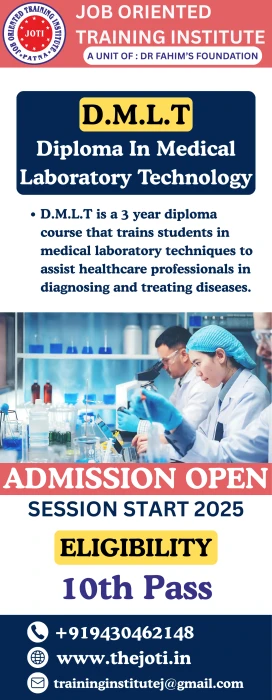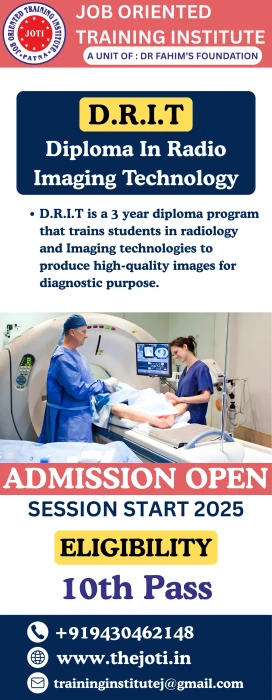 Near AIIMS Phulwari Sharif Patna
Near AIIMS Phulwari Sharif Patna [email protected]
[email protected] 7369848448
7369848448

The scope of a 3-year DMLT (Diploma in Medical Laboratory Technology) program for medical students is to provide a comprehensive education and training in medical laboratory technology, enabling them to:
1. Assist in diagnosis and treatment of diseases
2. Conduct laboratory tests and procedures
3. Operate and maintain laboratory equipment
4. Ensure quality control and quality assurance in laboratory testing
5. Understand the principles of laboratory safety and management
6. Apply knowledge of anatomy, physiology, biochemistry, and microbiology in laboratory testing
7. Develop skills in phlebotomy, blood banking, and transfusion medicine
8. Understand the principles of molecular diagnostics and cytogenetics
9. Apply knowledge of immunology and serology in laboratory testing
10. Develop skills in laboratory instrumentation and maintenance
11. Understand the principles of research methodology and biostatistics
12. Apply knowledge of laboratory management and administration
13. Develop skills in clinical correlation and case studies
14. Prepare for higher studies or specialization in medical laboratory technology
15. Pursue a career as a medical laboratory technician or technologist
By completing a 3-year DMLT program, medical students can gain a comprehensive understanding of medical laboratory technology and develop the skills and knowledge necessary to excel in this field.
Here is a syllabus for a 3-year DMLT (Diploma in Medical Laboratory Technology) program: Year 1: - Semester 1: - Anatomy and Physiology - Biochemistry - Introduction to Medical Laboratory Technology - Laboratory Safety and Management - Semester 2: - Pathology - Microbiology - Hematology - Blood Banking and Transfusion Medicine Year 2: - Semester 3: - Clinical Biochemistry - Medical Microbiology - Immunology - Serology - Semester 4: - Parasitology - Histopathology and Cytology - Laboratory Instrumentation and Maintenance - Quality Control and Quality Assurance Year 3: - Semester 5: - Molecular Diagnostics - Cytogenetics - Immunohematology - Laboratory Management and Administration - Semester 6: - Research Methodology and Biostatistics - Advanced Medical Laboratory Techniques - Clinical Correlation and Case Studies - Project Work/Dissertation Note: The syllabus may vary depending on the institution and the specific program. This is just a general outline. Additionally, there may be practical exams, viva voce, and project work throughout the program.

General syllabus for a 3-year program in Diagnostic Radiography and Imaging Technology (DRIT): Year 1: - Semester 1: - Anatomy and Physiology - Physics and Instrumentation - Introduction to Diagnostic Radiography - Radiographic Positioning and Techniques - Semester 2: - Radiographic Imaging and Processing - Radiation Safety and Protection - Patient Care and Management - Medical Ethics and Law Year 2: - Semester 3: - Diagnostic Radiography and Imaging Techniques - Computed Tomography (CT) Scanning - Magnetic Resonance Imaging (MRI) - Ultrasound and Sonography - Semester 4: - Radiation Therapy and Oncology - Nuclear Medicine and PET Imaging - Mammography and Breast Imaging - Cardiovascular and Interventional Radiology Year 3: - Semester 5: - Advanced Diagnostic Radiography and Imaging Techniques - Research Methods and Biostatistics - Quality Assurance and Quality Control - Healthcare Management and Administration - Semester 6: - Project Work/Dissertation - Clinical Practicum and Internship - Continuing Education and Professional Development Note that this is just a general outline, and the specific syllabus may vary depending on the institution and program. Additionally, some programs may have varying durations, such as 2 years or 4 years. It's always best to check with the institution for the most up-to-date and accurate information.